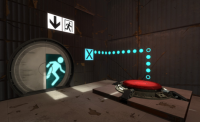prop_testchamber_door
Jump to navigation
Jump to search
| ??? |
prop_testchamber_door is a model entity available in ![]() Portal 2. A test chamber door entity. Essentially a prop_dynamic with more io, preset model, and less keyvalues.
Portal 2. A test chamber door entity. Essentially a prop_dynamic with more io, preset model, and less keyvalues.
Keyvalues
- Name (targetname) <string>
- The name that other entities refer to this entity by, via Inputs/Outputs or other keyvalues (e.g.
parentnameortarget).
Also displayed in Hammer's 2D views and Entity Report. - See also: Generic Keyvalues, Inputs and Outputs available to all entities
- Area Portal Window Name (AreaPortalWindow) <targetname>
- The name of an area portal window that is controlled by the door.
- Fade Area Portal? (UseAreaPortalFade) <boolean>
- If the area portal should use the specified fade distances to fade out.
- Fade Start Distance (AreaPortalFadeStart) <float>
- The distance at which the area portal starts fading out.
- Fade End Distance (AreaPortalFadeEnd) <float>
- The distance at which the area portal turns completely opaque.
|
Inputs
- Open
- Open the door and cause the portal to activate.
- Close
- Close the door and cause the portal to deactivate.
- LockOpen
- Opens the door and locks it.
- Lock
- Locking a door will prevent the Open or Close inputs from doing anything.
- Unlock
- If locked, unocking a door will allow the Open or Close inputs to function.
Outputs
- OnOpen
- Called when the door has started its open animation.
- OnClose
- Called when the door has started its close animation.
- OnFullyOpen
- Called when the door has finished its open animation.
- OnFullyClosed
- Called when the door has finished its close animation.
